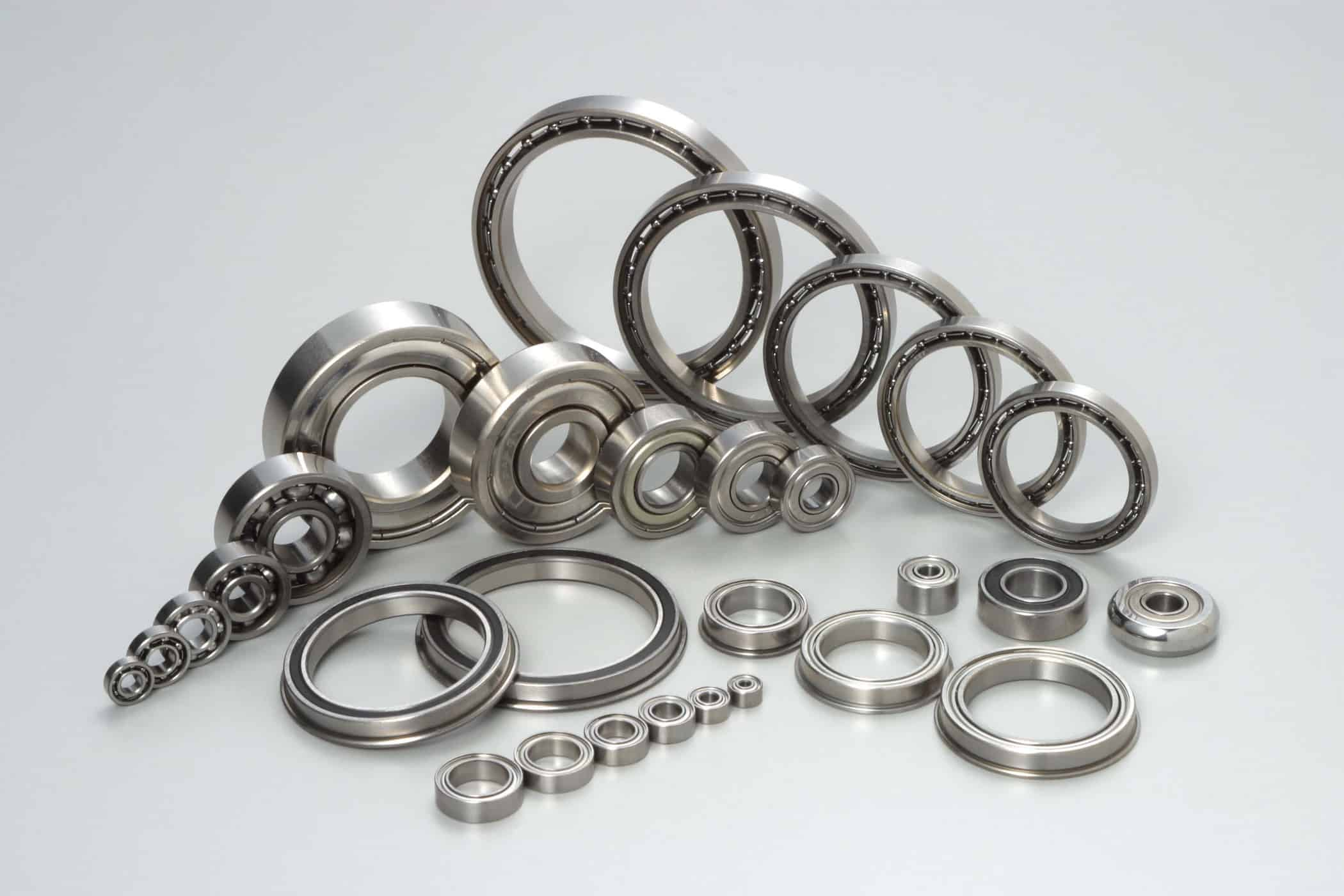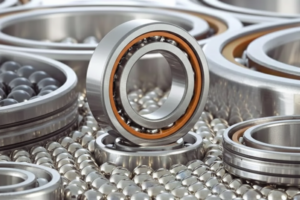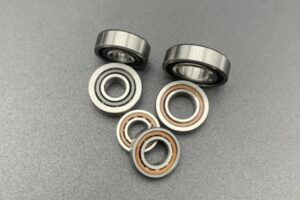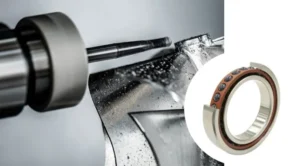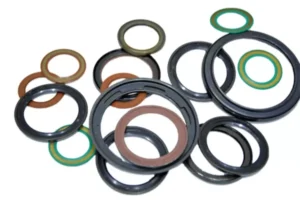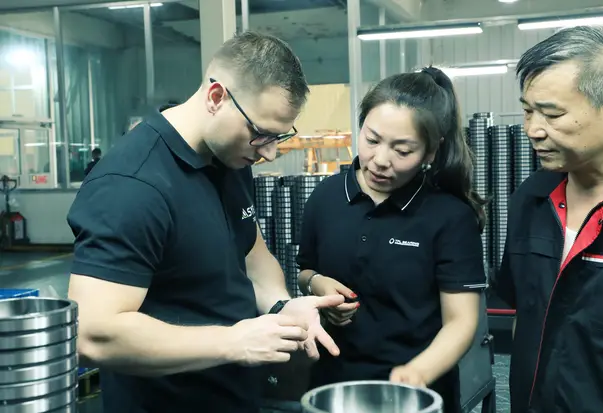Introduction
Generally speaking, a ball bearing consists of four components—an outer ring, an inner ring, balls, and the cage—as we discussed before.
Now that you know what a ball bearing is, you might be wondering, “Why do they look different sometimes?” That’s a great question! It turns out, there isn’t just one-size-fits-all.
There are actually many types of ball bearings, and the reason is simple: different jobs need different designs. How a ball bearing is put together – its actual structure – is what makes it perfect for certain tasks and not others.
Forget complicated technical jargon; we’ll keep to basic explanations so you may understand what distinguishes every structure and prepares it for its particular use. Let’s get right in!
Common Ball Bearing Types
Deep Groove Ball Bearings: The Most Common Type
What Does A Deep Groove Bearing Look Like?
These bearings have deep, curved paths (grooves) cut into the inner and outer rings. The bearing balls roll nicely in these grooves. This basic structure, often called a grooved ball bearing or deep groove bearing, is great because it can handle loads pushing down on the bearing (called radial loads) and also some loads pushing from the side (axial loads). You might see these referred to as ball bearing deep groove types.

Single Row vs. Double Row Deep Groove Structures
Sometimes, you’ll see a single row ball bearing. This just means there’s one neat line of balls inside. It’s the most common setup for a groove bearing. But if you need something tougher, there are also double row ball bearings. Just like it sounds, these have two rows of balls sitting side-by-side. This double row ball bearing structure makes them stronger and able to handle heavier loads.

Angular Contact Ball Bearings: Built for Sideways Loads
The Special Angle in Angular Contact Bearings
If you could look inside an angular ball bearing, you’d see that the grooves on the inner and outer rings aren’t lined up straight across from each other like in a deep groove bearing. They’re offset a bit. This creates a sort of angle where the balls touch the rings. This special structure – sometimes just called an angular bearing – makes these angular contact bearings really good at handling loads that push from the side (axial loads), especially heavy ones going in one direction. They can also handle downward loads (radial loads) at the same time.

What’s the angle? The “contact angle” (how slanted the groove is) decides how much sideways vs. straight-down force the bearing can handle.
| Contact angle | 15° | 30° | 40° | 25° |
| Contact angle code | C | A | B | AC |
Sealed Angular Contact Bearings Structure
Nobody likes dirt getting into their bearings! To help out, some angular contact bearings have seals built right into their structure. These sealed angular contact bearings keep dirt and gunk out, and keep the important grease inside. This helps them last longer, especially if things get messy.
Open Bearings: No seals or shields, suitable for high-speed applications where external sealing is provided.
Metal Shields (ZZ): Provide basic protection against dust and debris while allowing for high-speed operation.
Rubber Seals (2RS): Provide outstanding sealing ability to keep lubricants intact and stop contamination. But friction could cause them to somewhat lower the maximum running speed.

Self-Aligning Ball Bearings: When Things Aren’t Perfectly Straight
Sometimes in a machine, things don’t line up exactly right. Maybe the long metal rod (shaft) bends just a tiny bit, or the hole it sits in isn’t perfectly straight. No worries! Self aligning ball bearings are made for just this problem.

Their special trick is in the structure: the outer ring has a curved shape on the inside, like the inside of a bowl or part of a ball. This sometimes gives them the name sphere ball bearing or spherical ball bearing.
Because that outer track is curved, the inner parts (the inner ring with the balls and cage) can actually tilt or wobble a bit inside it. This means the self aligning ball bearing can adjust itself if the shaft isn’t perfectly lined up.

Thrust Ball Bearings: Just for End Pushes
These bearings have one main job: handling pushes that go straight onto the end of a spinning part. Think about sitting on a spinning stool – the force pushing down is the kind of load these handle. It’s called thrust load or axial load.
The structure of a ball thrust bearing usually looks like two flat metal washers with grooves, with the balls rolling between them. They aren’t really made to handle pushes from the side.
You’ll find these in things like lazy Susans (rotating trays), certain kinds of lifting jacks, and anywhere the main push is along the line of the shaft, not sideways.

Linear Ball Bearings: Sliding Straight
Okay, most bearings help things spin around. But linear ball bearings are different – they help things slide back and forth smoothly in a straight line.
Their structure often has balls rolling between a smooth shaft and an outer part (sometimes called a ball bushing bearing). The clever bit is how the balls move: they roll along the shaft, then loop around through tracks inside the outer part to get back to the start. They keep circulating around.

This ball bushing bearing structure lets things slide back and forth along a rod with very little friction. Think about how smoothly a drawer opens or how parts move on a 3D printer.
Often, these parts work together as a team. A linear guide ball bearing system usually includes the special rail (the guide) and one or more blocks that slide along it, using those circulating balls. This structure gives you really precise straight-line movement. You might hear the name ball linear bearing used here too.

Special Ball Bearing Types You Should Know
Pillow Block Ball Bearings: Easy to Mount
Need to bolt a bearing onto a flat surface quickly? A pillow block ball bearing is your friend. It’s not really a different type of bearing inside, but a unit. The structure is a standard bearing (like a deep groove one) that already comes mounted inside a solid metal block (the “pillow block”). You just take the whole unit and bolt it down where you need it. Super easy!

Flanged Ball Bearings: Easy to Place
Flanged ball bearings have a little extra ring or lip on the outside, called a flange. This flange makes it easier to put the bearing in the right spot and helps hold it in place. It’s like having a built-in washer.
Thin Section Bearings Structure
Imagine a normal ball bearing, but squished really thin. That’s kind of what thin section bearings are like. Their structure has very thin rings compared to how big the hole is. This build saves a lot of space and weight. You often find this structure in robots, machines for making computer chips, or even things that go into space!
How to Tell the Difference Between Ball Bearing Types
Still not sure which one’s right? Here are a few tips that can help you spot the difference.
Ball Bearing Assembly
How a bearing is built changes how it works.
- Some are sealed — they keep out dirt and last longer.
- Some are open — easier to clean or oil.
- Some need special mounts.
Each style fits certain jobs better, so check the setup.
Single Row vs. Double Row Ball Bearings
This one’s pretty easy:
- Single row ball bearing: handles light to medium loads.
- Double row ball bearings: handles more pressure and stress.
If your machine gets heavy use, go double.
Self Aligning vs. Fixed Bearings
- Self aligning ball bearing: moves a little to fix alignment problems.
- Fixed types like the deep groove bearing stay in one position.
If your shaft might shift, go with self aligning.
Ball Bearing Types Chart (Quick Look)
Here’s a simple chart you can use when picking a bearing.
| Type | Best For | Load Direction |
| Deep Groove Ball Bearing | Everyday machines | Radial & light axial |
| Angular Contact Bearings | High-speed tools | Axial (one direction) |
| Spherical Ball Bearing | Misaligned shafts | Radial & axial |
| Ball Thrust Bearing | Low-speed applications | Axial only |
| Linear Ball Bearing | Straight-line movement | Linear motion |
| Pillow Block Ball Bearing | Easy mounting | Radial |
| Thin Section Bearings | Tight spaces | Radial & light axial |
Conclusion
So, from the angular contact ball bearings that handle forces at angles to the deep groove ball bearings that are great for everyday spinning, and even the linear ball bearings that let things slide smoothly, there are lots of different kinds of ball bearings. Each one has its own special structure that makes it good for certain jobs. Picking the right ball bearing types helps your machines run great and last a long time.
Why not head over to our website? Or just give us a shout at TFL Bearings today! We’re here to help you find the perfect bearing for what you need. Get solid performance you can trust with TFL Bearings!
👉 Need help picking one? Reach out to us or check out our product list. We’re here to make it easy.
Top 5 Questions People Ask About Ball Bearings
What’s the difference between a ball bearing and a roller bearing?
Ball bearings use little round balls to help things move, while roller bearings use little cylinders or other shapes that roll. Ball bearings are usually better for things that spin fast and don’t have super heavy loads.
What is the difference between single row and double row ball bearings?
It’s quite straightforward. A single-row ball bearing only consists of one circle of bearing balls. Two side-by-side circles of balls make up a double-row ball bearing construction. Usually more robust and able to take more weight are these two-row ball bearings.
Do thin bearings break easily?
Nope! Our thin section bearings are lightweight but still tough.
How do I know what size ball bearing I need? Usually, you’ll need to look at the instructions for your machine or check the old bearing that you’re replacing. There are usually numbers printed on the bearing that tell you its size.
How long do ball bearings usually last?
That really depends on how they’re used and if they’re taken care of. If you keep them clean and put grease on them when you need to, they can last for many years.
